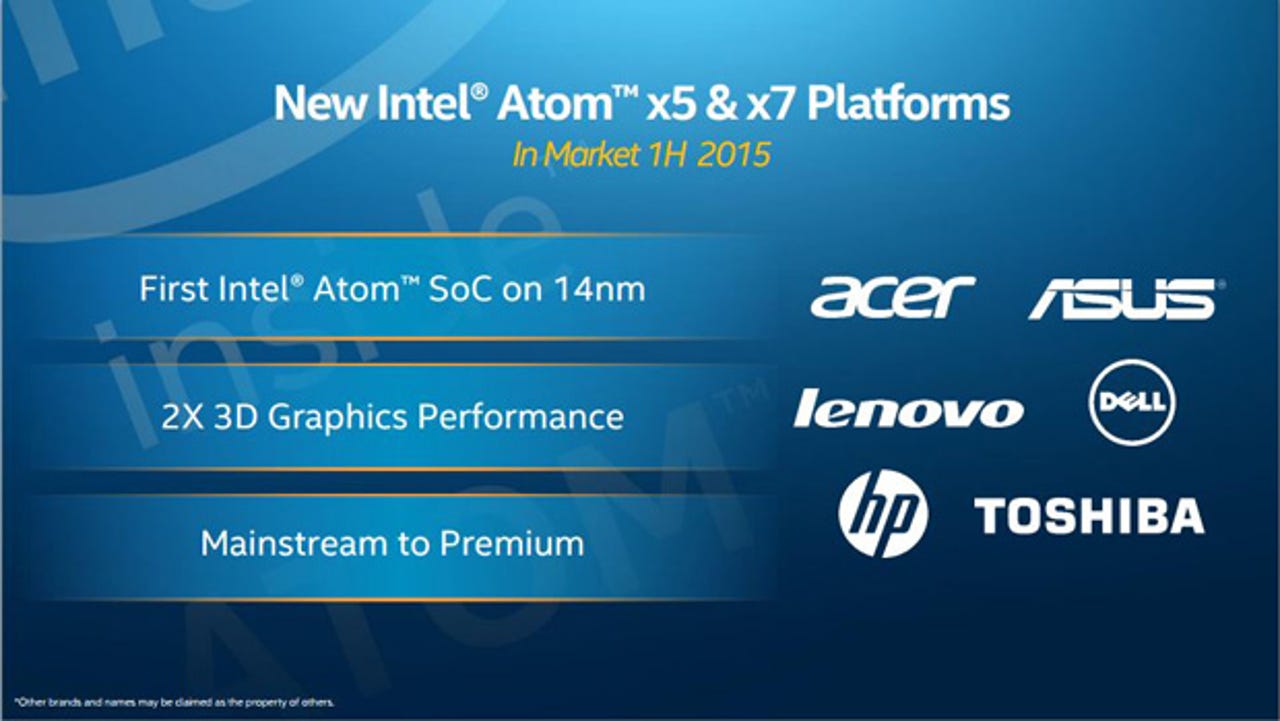Beneath the Surface 3: Intel's 14nm Atom Cherry Trail chip

The Surface 3 signals the end of Microsoft's experiment with Windows RT. But is also notable because it is likely to be the first device, when it ships on May 5, to offer an Atom chip based on Intel's most advanced 14nm process. Intel officially announced the new line--along with a rebranding to mirror the more powerful Core family--at last month's Mobile World Congress.

The Atom x5 and x7 series, formerly known as Cherry Trail, are designed for tablets and smaller 2-in-1 devices. These are manufactured on the same advanced 14nm process with FinFET transistors as the Broadwell Core processors and they use a new Airmont CPU core and Intel's latest Gen8 graphics. Cherry Trail replaces the 22nm Bay Trail-T platform with the Silvermont core (the Atom Z3700 Series) for Android and Windows tablets. A separate 14nm platform, code-named Braswell, replaces the Bay Trail processors for low-end notebooks and desktops sold under the Celeron and Pentium brands.
The Cherry Trail quad-core processors include the x5-8300, which has 12 graphics execution units (EUs), the x5-8500, which has a faster CPU, and x7-8700, which has the faster CPU and more powerful graphics (16 EUs). The Surface 3 uses the 1.6GHz x7-8700 (early test results posted on Geekbench suggest it is slightly faster than Bay Trail but notably slower than both the Surface Pro 3 with a Core i5-4300U and the Apple iPad Air 2, which also starts at $499). Intel has said that Acer, Asus, Dell, HP, Lenovo and Toshiba will also release devices using the x5 and x7 processors.
Featured
The Atom x3, formerly known as SoFIA, is Intel's first processor with an integrated wireless baseband and is designed for low-end smartphones and tablets. These are manufactured by an outside foundry, almost certainly TSMC, on a more mature 28nm process and they use ARM's Mali graphics.
The Atom x3-C3130 has a dual-core CPU, dual-core Mali-400 graphics and a 3G baseband. The x3-C3230RK, which was designed with Rockchip, has a faster quad-core CPU, quad-core Mali-450 graphics and the same modem. The top-of-the-line x3-3440 has a faster CPU, Mali-T720 graphics (which adds support for modern programming interfaces including OpenGL ES 3.0, DirectX 9 and OpenCL) and a 4G LTE baseband. This will be Intel's first processor with an integrate LTE modem when it ships later this year; the x3-3130 is already shipping and the x3-3230RK will be available in the first half of 2015. Intel has said that 20 companies plan to release x3 smartphones or phablets, but it has yet to land a major global smartphone supplier.
Intel is making some progress in mobile, but it is still playing catch up to the competition.
Samsung started production of its first 14nm mobile processor, the Exynos 7420, in February. The eight-core processor (four Cortex-A53 cores and four Cortex-A57 cores) powers the Galaxy S6 and S6 Edge smartphones, which will be available starting April 10. Based on a new ChipWorks teardown and some information on wireless operator sites, it looks like Samsung has also started using its own basebands and RF transceivers, in place of Qualcomm or Intel chips, wherever possible.
Qualcomm's Snapdragon 810 also uses four A53 cores and four A57 cores, but it is manufactured on TSMC's 20nm process (without 3D FinFET transistors) and has an integrated LTE-Advanced Category 9 450Mbps modem. It is used in the LG G Flex2 and the Xiaomi Mi Note Pro among other smartphones. The company's first processor with FinFETs (either TSMC's 16nm process or the Samsung/GlobalFoundries 14nm process), the Snapdragon 820 with Qualcomm's custom 64-bit Kryo, will be sampling by the end of the year but won't show up in smartphones until 2016.
Like the Snapdragon 810, the Apple A8 (iPhone 6 and iPhone 6 Plus) and A8X (iPad Air 2) are made by TSMC on its 20nm planar process. But Samsung may have won back much of Apple's business on the A9 because of its lead on FinFETs.
More Surface 3
- Microsoft's new Atom-based Surface 3, starting at $499, to hit in May
- Microsoft's new Surface 3 is a serious contender to the iPad
- Surface 3 hits sweet spot for both business pros and consumers